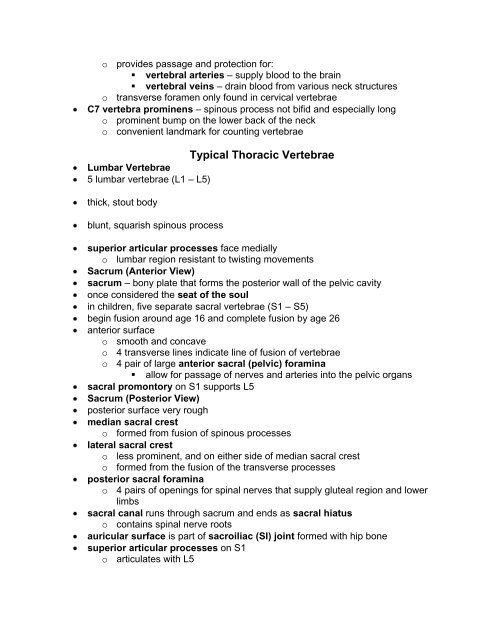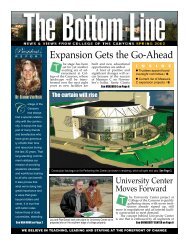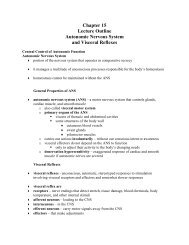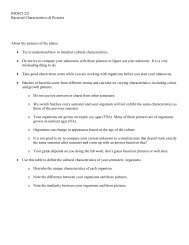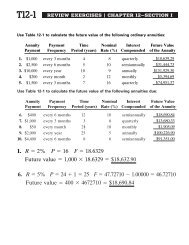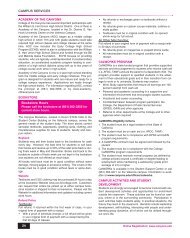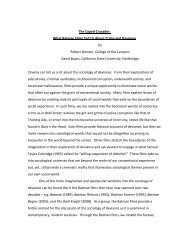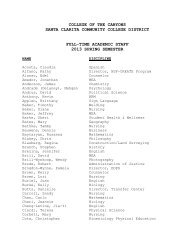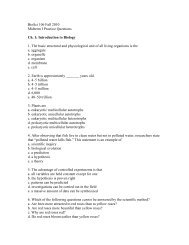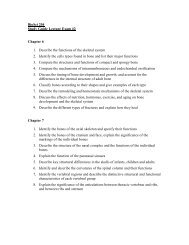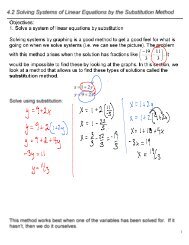Chapter 8 Lecture Outline The Skeletal System Overview of the ...
Chapter 8 Lecture Outline The Skeletal System Overview of the ...
Chapter 8 Lecture Outline The Skeletal System Overview of the ...
You also want an ePaper? Increase the reach of your titles
YUMPU automatically turns print PDFs into web optimized ePapers that Google loves.
o provides passage and protection for:<br />
vertebral arteries – supply blood to <strong>the</strong> brain<br />
vertebral veins – drain blood from various neck structures<br />
o transverse foramen only found in cervical vertebrae<br />
C7 vertebra prominens – spinous process not bifid and especially long<br />
o prominent bump on <strong>the</strong> lower back <strong>of</strong> <strong>the</strong> neck<br />
o convenient landmark for counting vertebrae<br />
Typical Thoracic Vertebrae<br />
Lumbar Vertebrae<br />
5 lumbar vertebrae (L1 – L5)<br />
thick, stout body<br />
blunt, squarish spinous process<br />
superior articular processes face medially<br />
o lumbar region resistant to twisting movements<br />
Sacrum (Anterior View)<br />
sacrum – bony plate that forms <strong>the</strong> posterior wall <strong>of</strong> <strong>the</strong> pelvic cavity<br />
once considered <strong>the</strong> seat <strong>of</strong> <strong>the</strong> soul<br />
in children, five separate sacral vertebrae (S1 – S5)<br />
begin fusion around age 16 and complete fusion by age 26<br />
anterior surface<br />
o smooth and concave<br />
o 4 transverse lines indicate line <strong>of</strong> fusion <strong>of</strong> vertebrae<br />
o 4 pair <strong>of</strong> large anterior sacral (pelvic) foramina<br />
allow for passage <strong>of</strong> nerves and arteries into <strong>the</strong> pelvic organs<br />
sacral promontory on S1 supports L5<br />
Sacrum (Posterior View)<br />
posterior surface very rough<br />
median sacral crest<br />
o formed from fusion <strong>of</strong> spinous processes<br />
lateral sacral crest<br />
o less prominent, and on ei<strong>the</strong>r side <strong>of</strong> median sacral crest<br />
o formed from <strong>the</strong> fusion <strong>of</strong> <strong>the</strong> transverse processes<br />
posterior sacral foramina<br />
o 4 pairs <strong>of</strong> openings for spinal nerves that supply gluteal region and lower<br />
limbs<br />
sacral canal runs through sacrum and ends as sacral hiatus<br />
o contains spinal nerve roots<br />
auricular surface is part <strong>of</strong> sacroiliac (SI) joint formed with hip bone<br />
superior articular processes on S1<br />
o articulates with L5


